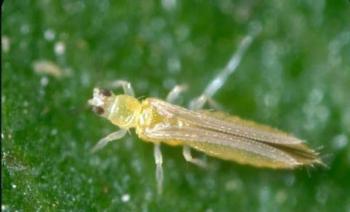Western flower thrips

Western flower thrip
First instar nymphs are opaque or light yellow, turning to golden yellow after the first molt. The nymphal stage lasts from 5 to 20 days.
Western flower thrips overwinter as adults in weeds, grasses, alfalfa, and other hosts, either in the orchard floor or nearby. In early spring, if overwintering sites are disturbed or dry up, thrips migrate to flowering trees and plants and deposit eggs in the tender portions of the host plant, e.g. shoots, buds, and flower parts. The peak infestation is usually reached in May or June.
(Description from UC Pest Management Guidelines)

